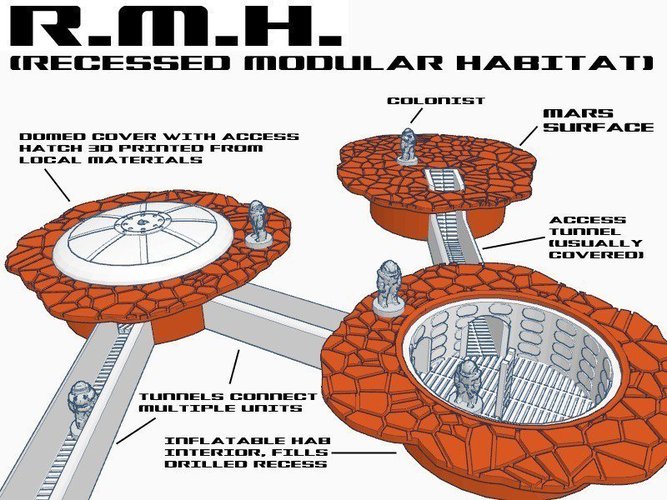
R.M.H. (Recessed Modular Habitat)
pinshape
The Reusable Modular Habitat is designed to utilize the maximum amount of available Martian resources to minimize transported supplies and costs. A long-term mission to Mars requires addressing primary concerns like water, air, and food; secondary concerns include temperature control, power generation, and defense against harsh weather conditions. Proposed solutions will be discussed in detail below. The proposed mission involves two phases with separate launches approximately two years apart to coincide with optimal Martian launch windows. During Phase 1, the first rocket carries equipment, elemental sodium, potassium nitrate, communications gear, and five robots. A landing site is chosen based on proximity to a polar region with significant ice deposits and notable geothermal activity. Upon landing, the robots start constructing the habitat. Robot1 digs three large cylinders into the Martian landscape, about twenty feet across and ten feet deep. These recesses form the superstructure of the three rooms in our habitat. This format was chosen because lowering the habitat below the surface makes it robustly insulated and impervious to windstorms. As this process takes place, Robot2 gathers a large supply of ice from nearby ice fields. The ice is melted down and mixed with sodium to form sodium hydroxide and hydrogen. Hydrogen is captured for short-term power generation, while sodium hydroxide is mixed with ferric oxide from the nearby excavation. A generator burns hydrogen fuel to produce electricity, which in turn is used to electrolyze the chemical mixture and produce pure powdered iron. Robot3 disassembles the landing module, reconfigures it into a set of rails, an electric furnace, and manufacturing setup. Once Robot1 finishes its first hole, Robot4 descends into the hole as Robot1 exits. Robot4 burrows a narrow tunnel straight down to the geothermal hotspot, installing behind it a pair of sectional pipes. Robot4 acts as a control valve at the bottom of these exchange pipes, initiating the pipe-laying process to designate the first room as the eventual home of the geothermal steam turbine or "power plant" of the habitat. Geothermal power is chosen because dust, dust-storms, and distance from the sun make solar power impractical. As Robot1 starts on the second cylinder, Robot2 gathers a second load of ice. Robot3 unpacks and installs the steam turbine atop the geothermal piping, initiating closed-cycle steam generation and bringing on-site power online. Robot3 connects the factory setup to the power supply as Robot2 loads iron powder into it for melting. Robot3 boils a mixture of water, potassium nitrate, and sodium hydroxide to create a chemical sealant applied to the iron. At this point, Robot5 begins extruding molten iron across the surface of an inflatable dome-mold to create the roof-caps of our three rooms. Each cap has a circular hole in the top for a hatch installation later. Once the domes are molded, Robot3 applies a coat of sealant while Robot2 lays sections of railing across the newly dug holes. This railing will be used as support when the domes are slid into place to form subterranean rooms. Robot1 burrows connecting tunnels between the three rooms, completing the superstructure of our habitat. In Phase 2, a second rocket carries the team of scientists, dehydrated food supplies, lab equipment, and furnishings for the RMH. Once landed, they finish the interiors of the habitat, focusing on the power plant and installing bunks, dining facilities, lab equipment, bio-waste recycling equipment, and power routing throughout. Doors and hatches are installed next, followed by sliding the domes into place to complete the habitat. Sodium hydroxide produced during Phase 1 is integrated into air scrubbers, generating a supply of sodium bicarbonate for waste-water filtration.
With this file you will be able to print R.M.H. (Recessed Modular Habitat) with your 3D printer. Click on the button and save the file on your computer to work, edit or customize your design. You can also find more 3D designs for printers on R.M.H. (Recessed Modular Habitat).
